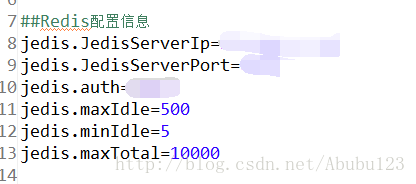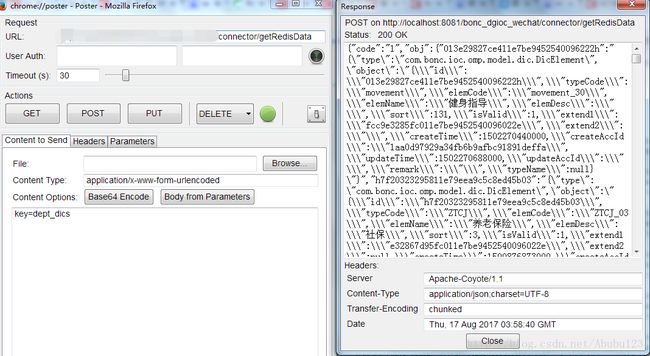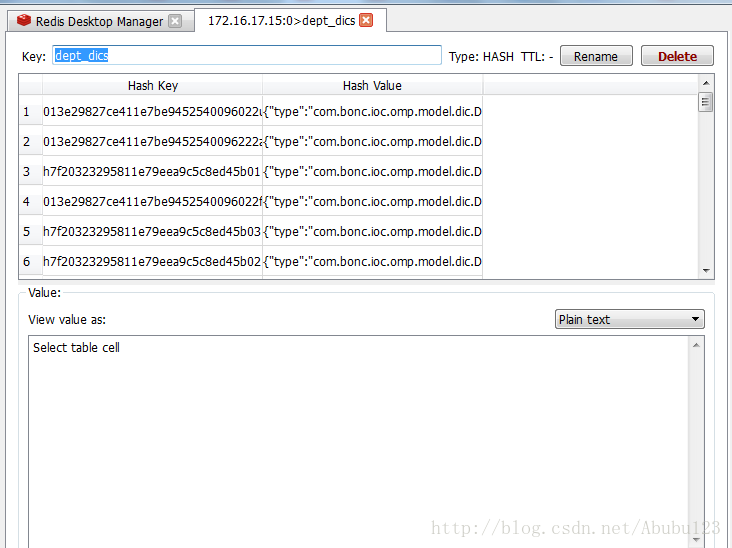SSM框架集成Redis数据库【Redis·4】
最近项目中引进redis用来存放图片或者一些不常修改的数据,以减轻程序及数据库压力。记录下配置过程。
框架:SpringMVC+Mybatis
版本:
Spring4.0
Mybatis3.0
jedis-2.9.0
spring-data-commons-1.8.6.RELEASE.jar
spring-data-redis-1.8.6.RELEASE.jar
备注:如果是Spring3.0 的版本,请使用低版本的 jedis-2.4.2.jar spring-data-commons-core-1.4.0.RELEASE.jar spring-data-redis-1.4.2.RELEASE.jar
redis配置
1、将下载好的jar包放入项目中。
jedis-2.9.0 下载 spring-data-commons-1.8.6.RELEASE.jar 下载 spring-data-redis-1.8.6.RELEASE.jar下载
2、创建一个spring-context-redis.xml,将redis相关信息集成进Spring中
注:hashValueSerializer 是 自己配置的用来序列化的类,可以注掉,也可以改用jedis本身的序列化方法。
在config.properties中配置好连接地址,端口,密码等信息。
3、在web.xml中注册刚才配置的文件,保证项目启动后能够加载

至此redis已经集成进了项目之中,可能出现的错误就是版本不匹配,即Spring的版本与jedis的版本不匹配产生的,更换相应的版本即可。
redis的使用
1、完成redis配置后,需要创建一个redis的工具类 或者 是 service方法,用来方便的调用redis中的相关增删改查的方法
package com.bonc.wechat.services.redis;
import java.util.HashMap;
import java.util.Map;
import java.util.Map.Entry;
import java.util.Set;
import org.springframework.beans.factory.annotation.Autowired;
import org.springframework.data.redis.core.HashOperations;
import org.springframework.data.redis.core.RedisTemplate;
import org.springframework.data.redis.core.ValueOperations;
import org.springframework.stereotype.Service;
import com.bonc.wechat.common.util.JSONUtil;
import com.bonc.wechat.common.util.RedisDecodeUtil;
@Service
public class RedisService {
@Autowired
RedisTemplate redisTemplate;
/**
* 清楚缓存对象
* @param rkey
* @throws Exception
*/
public void del(String rkey) throws Exception {
redisTemplate.delete(rkey);
}
/**
* 向redis缓存放入任意对象
* @param rkey Map键
* @param map
* @throws Exception
*/
public void oset(String rkey, Object object) throws Exception {
ValueOperations value = redisTemplate.opsForValue();
if(object instanceof String){
value.set(rkey, object.toString());
}else{
value.set(rkey, JSONUtil.serialize(object,true));
}
}
/**
* 向redis缓存放入Map
* @param rkey Map键
* @param map
* @throws Exception
*/
public void oset(String rkey, Map map) throws Exception {
oset(rkey,map,false);
}
/**
* 向redis缓存放入Map
* @param rkey Map键
* @param map
* @param override 是否覆盖
* @throws Exception
*/
public void oset(String rkey, Map map, boolean override) throws Exception {
del(rkey);
// if(override) {
// }
HashOperations objList = redisTemplate.opsForHash();
Set> keys = map.entrySet();
Map temp = new HashMap();
for (Entry entry : keys) {
temp.put(entry.getKey(), JSONUtil.serialize(entry.getValue(),true));
}
objList.putAll(rkey,temp);
}
/**
* 自增
* @param rkey 存放在redis的key
* @return
* @throws Exception
*/
public Long incr(String rkey) throws Exception {
return incrBy(rkey, 1L);
}
/**
* 自增
* @param rkey 存放在redis的key
* @return
* @throws Exception
*/
public Long incrBy(String rkey,long l) throws Exception {
ValueOperations value = redisTemplate.opsForValue();
return value.increment(rkey, l);
}
/**
* 取出String
* @param rkey 存放在redis的key
* @return
* @throws Exception
*/
public String get(String rkey) throws Exception {
ValueOperations value = redisTemplate.opsForValue();
Object val = value.get(rkey);
return val==null?null:val.toString();
}
/**
* 取出对象
* @param rkey 存放在redis的key
* @return
* @throws Exception
*/
public Object oget(String rkey) throws Exception {
switch(redisTemplate.type(rkey).code()){
case "string":
ValueOperations value = redisTemplate.opsForValue();
return RedisDecodeUtil.parse(value.get(rkey).toString());
case "hash":
HashOperations objList = redisTemplate.opsForHash();
return objList.entries(rkey);
default:
return null;
}
}
/**
* 按类型获取
* @param rkey 存放在redis的key
* @param cls value的类类型
* @return
* @throws Exception
*/
@SuppressWarnings("unchecked")
public T oget(String rkey, Class cls) throws Exception {
return (T) oget(rkey);
}
/**
* 按类型获取Map值
* @param rkey 存放在redis的key
* @param key map的key
* @param cls value的类类型
* @return
* @throws Exception
*/
@SuppressWarnings("unchecked")
public T oget(String rkey, String key, Class cls) throws Exception {
return (T) hget(rkey,key);
}
/**
* 获取map值
* @param rkey 存放在redis的key
* @param key map的key
* @return
* @throws Exception
*/
public Object hget(String rkey,String key) throws Exception {
if(redisTemplate.hasKey(rkey)){
HashOperations objList = redisTemplate.opsForHash();
return objList.get(rkey, key);
}
return null;
}
}
备注:JSONUtil 与 RedisDecodeUtil 下载地址
2、controller中调用。
@Resource
private RedisService redisService;/**
* 从redis中获取数据
* 返回值为对象
*/
@RequestMapping(value="/getRedisData")
@ResponseBody
public AppReply getRedisData(@RequestParam("key")String key){
AppReply appReply = new AppReply<>();
try {
Object obj = redisService.oget(key);
if(obj != null){
appReply.setCode("1");
appReply.setObj(obj);
}else{
appReply.setCode("0");
appReply.setObj(null);
}
} catch (Exception e) {
e.printStackTrace();
}
return appReply;
} 3、返回数据查看
返回结果:
数据库数据:
至此,SSM整合redis就全部完成。


